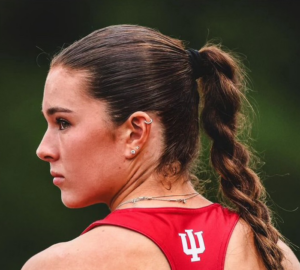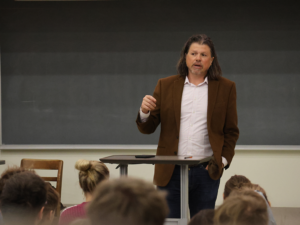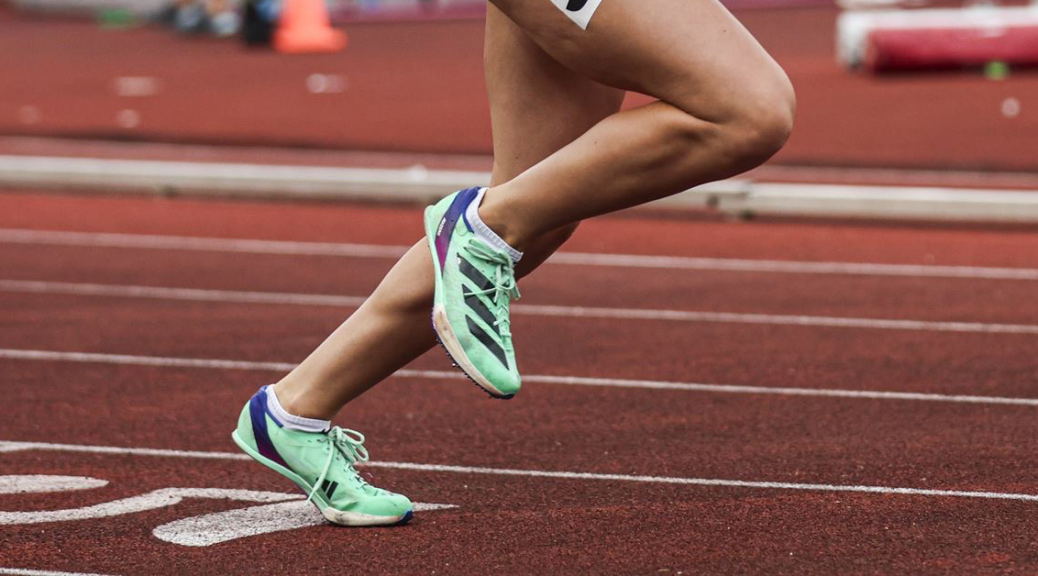By Zoe Reed, Ronae Lyons, and Luke Burton
BLOOMINGTON, Ind. (Nov. 5, 2024) –
Campbell Wamsley runs along the burnt-red path; her footsteps are heard across the field as they slap across the rough, rocky floor. She takes a deep breath, feeling the cold air fill her lungs, pushing against her ribcage, and exiting three seconds later, a cloud of warm air in its path. She focuses on the white line before her, ignoring every other sense that tries to enter her consciousness. As she gets closer, her heart thumps in her chest, causing an echo from her ribs to her head, a countdown. She starts to gain encouragement from hearing the cheers of her friends and family, the inevitable win in the back of her mind, forcing her to continue. She knows through this win; her favorite brand will reach out to her, gaining free items and maybe finally reaching her follower goal. Cambell is one of the only sophomore Track & Field players who are a part of NIL, and she plans to show the world her talent.
On July 1st, 2021, the National Collegiate Athletics Association, more well-known as the NCAA, welcomed a new concept never seen before in college athletics. Name, Image, Likeness, or NIL, is a way for college athletes to profit from brands, organizations, or businesses using their name, image, or likeness. Although any athlete can join NIL, some main concepts must be reached before contacting businesses. These include follower counts on social media and a love for what you do. Cambell is a star athlete for IU’s long-distance and track and field sports at Bloomington and uses her skill to gain more money and attention from fans and future partners. “Although my sports aren’t the main focus of the NIL, with sports like Football and Basketball farther up on the priority list, I can use my own experiences, which I do for fun, as a way to improve my networking and media-making as an influencer,” states Cambell, wearing head-to-toe IU gear, following “that being said, I think the NIL should be taught more to incoming students, as it is a very beneficial system that is totally up to the athletes comfort.” Though there is a long list of positive experiences with NIL, athletes and even NIL directors will bring up some main concerns with the system implemented only three years ago. So far, we see these potential downsides, including hurting the athletes’ academics, widening the gap among athlete groups, and creating extra pressure to perform.
NIL benefits aren’t evenly spread across college athletes and the

sports they perform. For Indiana University Bloomington, our top sports with the highest viewers per game are football and Indiana’s classic, basketball. Because of this, athletes participating in these sports often receive and secure more significant deals with more extensive benefits. In contrast, athletes in more minor sports may receive little to no attention. This imbalance creates tension and possibly resentment among teammates. For instance, a quarterback might land a major endorsement deal with big brands like Adidas or Nike, while more minor athletes like a runner for the track and field team see little NIL revenue. This divide risks creating an uneven playing field within teams and across college sports programs, as high-profile players receive extra benefits and visibility that others do not. “I realized signing up for NIL as a sprinter might not grant me the same benefits as someone who is a part of the basketball team, but I believe everyone should have the same opportunity no matter the sport they play; it also makes me think of all the women athletes who may not have the same coverage simply because the men’s team is bigger or more known.” Cambell Wamsley states, bringing up another issue plaguing NIL deals: while top male athletes often secure large, lucrative deals, female athletes frequently have fewer opportunities despite strong performances or significant followings. This is due to various factors, including men’s sports receiving the most media coverage, increasing visibility, and sponsorship interest. On the other hand, female athletes, even with large social media followings or national championships, often struggle to attract that same level of endorsement. If questioning if this is a real problem, ask yourself, how many female athlete endorsements have you seen compared to male athlete endorsements?
With NIL focusing on college athletics, there is a very simple question many are asking about its logistics. With the lure of its earnings and benefits, some athletes might focus more on building their brands than on academics. For those with high-profile endorsements, it’s easy for studies to become a secondary priority. This can undermine the primary reason for college education, something many people have to fight for, for a short-term financial focus. Athletes who prioritize their brands over their studies might miss out on the broader benefits of a college degree. The emphasis on NIL deals can push some to choose less rigorous classes or avoid time-consuming majors, ultimately reducing their educational experience. To get more insight into this potential negative, we contacted Dr. Galen Clavio, director of the National Sports Journalism Center, who had this to say, “It’s always presented as an

either-or, either be in practice or you can focus on NIL; it’s not really how it works; professional athletes who are often a year older than college athletes effectively balance these things.” Dr. Clavio also raises another question, “Why is it that athletes are considered incapable of doing those things?” continuing that “A lot of how we approach athletes is we almost infantilize them, we treat them like they’re incapable of making their own decisions and making their own sets of prioritize, we don’t do that for other college students.”
While NIL rights offer college athletes new financial opportunities, they also bring unintended consequences. The benefits of NIL deals are often spread unevenly, with male athletes in high-profile sports like football or basketball seeing the majority of endorsements. This leaves female athletes and those in less-publicized sports with fewer opportunities, creating a significant gap within college sports. Additionally, the demands of managing these endorsements may shift the athlete’s focus away from academics, potentially undermining their college education. Balancing these opportunities with fair support and guidance is crucial for long-term success. In the rush to capitalize on NIL opportunities, we risk sidelining the true essence of college sports: growth, camaraderie, and education. As we move forward, it’s crucial to create a landscape where all athletes- regardless of sport or gender – can thrive equally on the field and in the classroom.
On the street interview about the stuggles of NIL deals. Jeremy Gray provides an inside to both the student and the school’s struggles with NIL.


